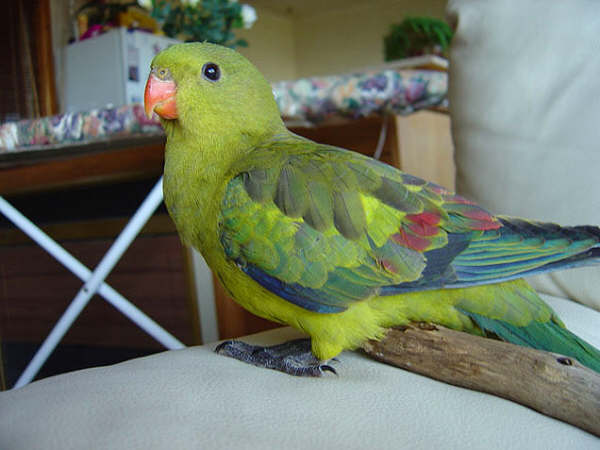
Regent parrot (Polytelis anthopeplus)
Phylum —chordata
Class — aves
Order — psittaciformes
Family — psittaculidae
Genus – polytelis
Appearance
A yellowish-green parrot, long and slender, with similar patterning exhibited by the sexes. They are between 14½–16½" (37–42 cm) in length and weigh four ounces. The female is generally more green, the male much yellower. The tail feathers above are dark blue-green, those beneath are black. The male is generally yellow, with several shades on the head; its back is generally a collection of colorful shades of green; its beak generally red.
Habitat
The bird is found primarily in eucalyptus groves and other wooded areas of subtropical southwestern Australia, as well as in a smaller area of subtropical and temperate southeastern Australia.
Behavior
It is a social bird, found in pairs or joining up to twenty others in flocks. The southwest subspecies, where it is common to abundant, may occur in mobs of up to one hundred birds. This produces an attractive spectacle when in flight. The movement in flight is fast and erratic, though described as graceful, with swept back wings.
Diet
Its diet consists of seeds of grasses and cereal crops, especially wheat. It also eats buds and flowers, insect larvae, psyllids and lerps. It forages in pairs or small parties, usually on the ground, but also in the canopy of trees or in spilled grain on the ground.
Reproduction
In their natural habitat, the Regents parrot typically nests in large, mature healthy trees with many spouts (though dead trees are used) close to a watercourse.The female broods 3-7 eggs for approximately 20 to 23 days. The first clutch is occasionally infertile as female is often in condition before the male.
During the incubation period, the hen seldom departs from the nest, if at all, and is fed by the male. When the young have hatched, they are cared for by both the male and female. During this period, they can be fed several times their normal portion of feed, which they readily convey to their young. The young begin to fly at about 35 days and are independent at 50 days. Sexual maturity is reached at about 2 years of age.
In captivity
Lifespan of these parrotsin captivity – 15-20 years.
Although they might look fragile and small at first glance, these parrots are actually hardy and robust. This is especially true when they are given the necessary attention and care. Remember that Regent parrots are excellent flyers and require a lot of free space. Besides a spacious cage, they need freedom of movement around the house. They will explore, follow you around and fly as much as they want. This exercise is a basis for good health and happiness.
Check your local pet stores for the regular seed mixes that are made especially for parakeets. They include a variety of millet seeds, sunflower and oats seeds and a lot of similar goodies. These mixes make a great basic diet which you’ll want to supplement with regular fresh fruits, nuts, and vegetables. Take care to replace fresh water sources on a daily basis as they have a tendency to bathe in every water dish that’s close by. You can also remedy this by regular showers, either in the bathroom or your kitchen sink.
For the most part, the Regent parrots are docile and affectionate parrots. They will create a bond from an early age, and as they establish trust, they will exhibit the funnier and more energetic side of their personality. With a few toys, free room and enough social interaction, you will quickly discover that a happy and healthy Regent parrot is a loving and calm pet parrot. Their docile behavior makes them suitable for aviaries and companion parrots.
 Russian
Russian
 English
English























